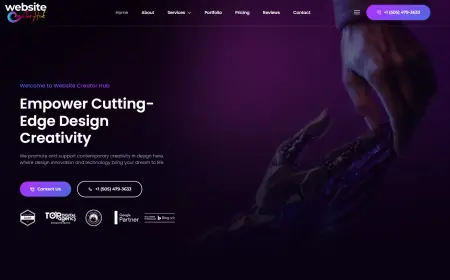Driving Efficiency Through Technology: IT Solutions for Streamlining Operations
In today’s fast-paced digital landscape, businesses face mounting pressure to optimize operations and stay competitive. Whether you're a small startup or an enterprise, maintaining efficiency while scaling can be a challenge. The key to navigating this complexity lies in adopting the right IT solutions that not only meet current needs but also future-proof your organization. In this post, we explore how technology and IT solutions are driving efficiency by streamlining operations.
Why Efficiency Matters in Business
Operational efficiency is not just a buzzword; it’s a critical component of business success. In an era where consumer expectations are high and competition is fierce, the ability to deliver products or services quickly, accurately, and at a lower cost can determine whether your business thrives or struggles.
Efficiency helps businesses:
- Reduce costs by eliminating waste and optimizing processes
- Improve customer satisfaction through faster, more reliable service
- Foster innovation by freeing up resources to invest in growth initiatives
- Enhance employee productivity and satisfaction
However, achieving operational efficiency is not an overnight process. It requires strategic planning, innovative technology, and continuous improvement. Here’s how IT solutions can help streamline your operations and set you up for long-term success.
IT Solutions That Drive Efficiency
1. Cloud Computing: Simplifying Infrastructure
One of the most significant innovations in recent years has been the widespread adoption of cloud computing. By transitioning to cloud-based infrastructure, businesses can streamline their operations by reducing the need for physical servers, IT maintenance, and in-house management of data storage. Cloud services offer flexibility, scalability, and cost savings, making them an essential tool for efficient operations.
Key benefits of cloud computing include:
- Scalability: Easily scale up or down based on demand without needing large capital investments.
- Cost Efficiency: Pay only for what you use, reducing overall IT expenses.
- Remote Access: Employees can access data and systems from anywhere, improving collaboration and reducing downtime.
Many companies are moving their entire operations to the cloud to enjoy these benefits while reducing the complexity of traditional IT infrastructure management.
2. Automation: Reducing Manual Workloads
Automation is transforming industries by enabling businesses to do more with fewer resources. Repetitive, manual tasks such as data entry, scheduling, invoicing, and customer service can be automated using advanced software solutions. This not only speeds up processes but also reduces the risk of human error.
Consider how automation can improve your business:
- Workflow Automation: Tools like Zapier, Asana, or Microsoft Power Automate allow you to streamline workflows by connecting different applications, so tasks are automatically assigned and completed based on triggers.
- Robotic Process Automation (RPA): RPA software like UiPath or Blue Prism can handle complex, high-volume tasks such as invoice processing or data migration.
- Customer Service Automation: Chatbots and AI-powered customer service solutions can answer frequently asked questions and provide 24/7 support, reducing the burden on human staff.
By automating tasks, businesses can focus on higher-value activities, drive faster processes, and eliminate bottlenecks.
3. Data Analytics: Making Informed Decisions
Data is the new oil, and businesses that harness its power can significantly boost their efficiency. Modern IT solutions offer advanced data analytics tools that provide deep insights into business performance, customer behavior, and market trends.
With real-time analytics tools like Power BI, Tableau, or Google Analytics, businesses can:
- Track Performance Metrics: Monitor key performance indicators (KPIs) in real-time, enabling quicker and more informed decision-making.
- Predict Trends: Use predictive analytics to forecast customer behavior, sales trends, and operational bottlenecks.
- Optimize Operations: Analyze workflow inefficiencies, production timelines, and other operational areas to streamline processes.
Data-driven decisions are more precise, allowing companies to allocate resources more effectively and increase overall productivity.
4. Collaboration Tools: Enhancing Communication
Effective communication is the backbone of any efficient operation. In today’s global and often remote workforce, collaboration tools are essential for keeping teams connected and aligned on goals.
Technologies like Slack, Microsoft Teams, and Zoom have revolutionized workplace communication by providing seamless collaboration, file sharing, and video conferencing. These platforms:
- Enhance Team Collaboration: Teams can collaborate in real-time, regardless of location, improving project timelines and outcomes.
- Centralize Communication: By using a single platform for all communication, teams avoid the confusion of juggling multiple tools.
- Boost Transparency: Teams can share updates, track progress, and keep stakeholders informed, promoting accountability and transparency across departments.
Effective collaboration reduces miscommunication, speeds up project completion times, and improves overall operational efficiency.
5. ERP Systems: Centralizing Business Operations
Enterprise Resource Planning (ERP) systems are comprehensive software solutions that centralize a company's core functions into a single platform. This includes finance, supply chain, manufacturing, human resources, and more. By integrating all of these functions, ERP systems streamline workflows, reduce redundancies, and provide visibility across the entire organization.
Some of the top ERP platforms include SAP, Oracle ERP, and Microsoft Dynamics 365, which offer the following benefits:
- Unified Data: All departments work from the same data set, improving accuracy and eliminating duplication.
- Improved Reporting: ERP systems provide a holistic view of business performance, making it easier to generate reports and track KPIs.
- Resource Optimization: By automating and centralizing processes, businesses can better allocate resources and reduce operational waste.
Implementing an ERP system may require an initial investment, but the long-term benefits of streamlining operations and improving efficiency far outweigh the costs.
Overcoming Challenges with IT Implementation
While IT solutions offer enormous benefits, implementing them is not without challenges. Businesses may face issues like:
- High Initial Costs: Some technologies, such as ERP systems, come with high upfront costs that may deter smaller businesses.
- Resistance to Change: Employees may resist adopting new technologies due to fear of the unknown or disruption to their current workflows.
- Security Concerns: As businesses digitize, they also become more vulnerable to cyber threats. Ensuring that IT solutions are secure is crucial to protecting sensitive data.
To overcome these challenges, businesses should take a phased approach to IT implementation, ensuring that employees receive proper training and that cybersecurity measures are in place.
Conclusion: The Future of Operational Efficiency
In a world where technology continues to evolve rapidly, businesses must adapt or risk falling behind. IT solutions are not just tools but strategic assets that can significantly enhance your operational efficiency. From cloud computing and automation to data analytics and ERP systems, the right technology can revolutionize how your business operates, freeing up resources for innovation and growth.
What's Your Reaction?
 Like
0
Like
0
 Dislike
0
Dislike
0
 Love
0
Love
0
 Funny
0
Funny
0
 Angry
0
Angry
0
 Sad
0
Sad
0
 Wow
0
Wow
0




















































